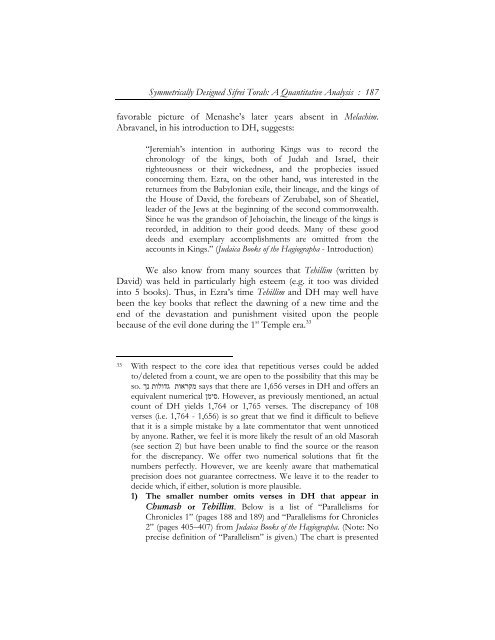Symmetrically Designed Sifrei Torah: A Quantitative Analysis - Hakirah
Symmetrically Designed Sifrei Torah: A Quantitative Analysis - Hakirah
Symmetrically Designed Sifrei Torah: A Quantitative Analysis - Hakirah
Create successful ePaper yourself
Turn your PDF publications into a flip-book with our unique Google optimized e-Paper software.
<strong>Symmetrically</strong> <strong>Designed</strong> <strong>Sifrei</strong> <strong>Torah</strong>: A <strong>Quantitative</strong> <strong>Analysis</strong> : 187<br />
favorable picture of Menashe’s later years absent in Melachim.<br />
Abravanel, in his introduction to DH, suggests:<br />
“Jeremiah’s intention in authoring Kings was to record the<br />
chronology of the kings, both of Judah and Israel, their<br />
righteousness or their wickedness, and the prophecies issued<br />
concerning them. Ezra, on the other hand, was interested in the<br />
returnees from the Babylonian exile, their lineage, and the kings of<br />
the House of David, the forebears of Zerubabel, son of Sheatiel,<br />
leader of the Jews at the beginning of the second commonwealth.<br />
Since he was the grandson of Jehoiachin, the lineage of the kings is<br />
recorded, in addition to their good deeds. Many of these good<br />
deeds and exemplary accomplishments are omitted from the<br />
accounts in Kings.” (Judaica Books of the Hagiographa - Introduction)<br />
We also know from many sources that Tehillim (written by<br />
David) was held in particularly high esteem (e.g. it too was divided<br />
into 5 books). Thus, in Ezra’s time Tehillim and DH may well have<br />
been the key books that reflect the dawning of a new time and the<br />
end of the devastation and punishment visited upon the people<br />
because of the evil done during the 1 st Temple era. 33<br />
33 With respect to the core idea that repetitious verses could be added<br />
to/deleted from a count, we are open to the possibility that this may be<br />
so. מקראות גדולות נך says that there are 1,656 verses in DH and offers an<br />
equivalent numerical .סימן However, as previously mentioned, an actual<br />
count of DH yields 1,764 or 1,765 verses. The discrepancy of 108<br />
verses (i.e. 1,764 - 1,656) is so great that we find it difficult to believe<br />
that it is a simple mistake by a late commentator that went unnoticed<br />
by anyone. Rather, we feel it is more likely the result of an old Masorah<br />
(see section 2) but have been unable to find the source or the reason<br />
for the discrepancy. We offer two numerical solutions that fit the<br />
numbers perfectly. However, we are keenly aware that mathematical<br />
precision does not guarantee correctness. We leave it to the reader to<br />
decide which, if either, solution is more plausible.<br />
1) The smaller number omits verses in DH that appear in<br />
Chumash or Tehillim. Below is a list of “Parallelisms for<br />
Chronicles 1” (pages 188 and 189) and “Parallelisms for Chronicles<br />
2” (pages 405–407) from Judaica Books of the Hagiographa. (Note: No<br />
precise definition of “Parallelism” is given.) The chart is presented
















